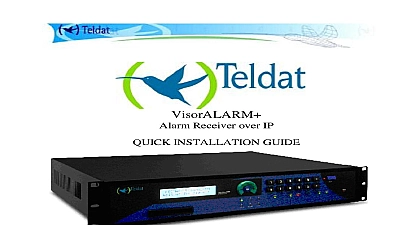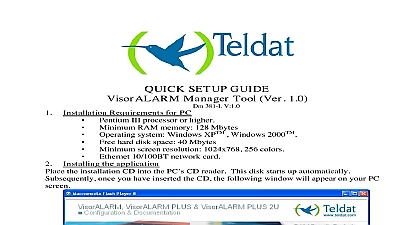Silent Night Teldat IP Alarm System Resiliency on Disaster Recovery and ISP changes Guide

File Preview
Click below to download for free
Click below to download for free
File Data
| Name | silent-night-teldat-ip-alarm-system-resiliency-on-disaster-recovery-and-isp-changes-guide-7169820543.pdf |
|---|---|
| Type | |
| Size | 816.42 KB |
| Downloads |
Text Preview
Alarm System Resiliency on Disaster and ISP changes better alternative to DNS based solutions 2 IP ALARM SYSTEM DESCRIPTION 3 DISASTER RECOVERY 4 THE CMS LOCATION OR IP SERVICE PROVIDER 4 DNS BASED SOLUTIONS ARE NOT A GOOD IDEA 5 1 IP Alarm providers have claimed for DNS based1 solutions as the unique means for overcoming typical challenges identified in a commercial IP Alarm Monitoring service order to benefit from the most competitive rates the CMS may need to change its Internet Provider to a new one This change should be carried out with little effort in the CMS and not imply manual reprogramming of the IP Communicator units During disasters the IP Communicators should switch to an alternative CMS automatically Communicators on Alarm Panels should not be locked to a specific CMS In other words the IP Communicators to a new commercial CMS should not imply manual of the units on the field the DNS gives an answer to these challenges it suffers from severe limitations that may put the Alarm Monitoring Service into jeopardy As such the FireLite IP Alarm System uses an alternative which not only gives an answer to these challenges but also does not suffer from the inherent of the DNS service DNS Domain Name System Among other services the DNS public service translates the DNS name of a IP machine into its IP address so it can be contacted from any host on the Internet 2 IP Alarm System description IP Alarm System uses the Internet as the main communication path between the traditional Alarm and the Central Monitoring Station CMS from now on As such two new elements are added into system The IPDACT is FireLite IP Communicator This element is connected to the Fire Panel DACT2 IPDACT formats the telephone alarm into IP and sends it over the Internet to the CMS The VisorALARM is FireLite IP Receiver It is installed in the Network Server room at the private network and it connects to the Automation Server over a serial line The reformats the IP alarm received from the IPDACTs into a well known alarm format Sur Gard and Radionics emulation and retransmits it to the Automation Server 1 FireLite IP Alarm network diagram 1 illustrates the basic IP Alarm System setup for Disaster Recovery A secondary CMS takes over Alarm Service when IPDACTs have lost the IP contact to their primary CMS VisorALARM receivers be clustered together leading to more complex architectures for Disaster Recovery These architectures out of the scope of this document nor shown in the Figure IP communication between IPDACTs and their Main and Backup VisorALARM is carried over the ARLY3 protocol which offers Connectionless transmission through low size packets This protocol is fully adapted to the Alarm transmission pattern Security Through packet encryption and other advanced techniques for the system protection replicas and against man in the middle attacks Reliability Through IP packet sequencing and retransmissions DACT Digital Alarm Communicator Transmitter It is the Alarm Panel module in charge of transmitting alarms over the external telephone line ARLY Alarm ReLaY It is the Teldat proprietary IP communication protocol for the Alarm Monitoring 3 Disaster Recovery disasters when the CMS staff must evacuate its facility or when the CMS IP Service goes down Service Providers are usually unable to forward the IP address space on their Internet connection to location In these circumstances prior to falling back to a phone line communication the IPDACT switches the IP to its secondary CMS compliance with the NFPA 724 signaling standard for OT PSDN5 the CMS notices the IP failure of a subscriber account within 90 seconds IPDACTs send polling request packets 90 seconds to the Main CMS and wait for the receiver response within that time interval two way If the IP polling fails the system goes on backup so that The main receiver triggers a Communication Loss alarm on that account The IPDACT switches to its backup receiver keeping the complete Alarm Monitoring service IPDACT will switch back to the main receiver on a normal operation as soon as the main IP has been recovered the CMS location or IP Service Provider of relying on the IP Alarm Monitoring Service on an external DNS service IPDACTs make use of tracking mechanisms offered by the ARLY communication protocol so that they can be reprogrammed the new CMS IP addresses backup and main with very little effort from the CMS administrator and manual reprogramming in each Fire Panel location Furthermore during the CMS IP address space the Alarm Monitoring Service will not be disrupted the Fire Panel installation the VisorALARM downloads into the IPDACT the IP addresses of the and Backup CMSs The VisorALARM picks the IP addresses from the appropriate IPDACT pattern in its Data Base On the other hand the VisorALARM keeps track of the IPDACTs IP address since it caches it during the last polling interval the IP address space of the CMS is modified the IPDACTs are reprogrammed without disrupting the Monitoring Service following these steps The new IP address space is activated into the Main CMS All the IPDACTs in the field switch to Backup CMS as the IPDACTs haven been informed yet on how to reach the Main CMS in new address The new IP address from the Main CMS is edited into the appropriate programming pattern of the VisorALARM Data Base With a one click operation into the VisorALARM Manager the IPDACTs are batched reprogrammed Once the batch reprogramming is completed all the IPDACTs in the field will then reconnect to Main CMS at the new address NFPA National Fire Protection Association OT PSDN Other Transmission technologies Packet Switched Data Networks This standard details the required for an IP Communicator device so it does not need to fallback to a telephone alarm in case that the IP Communication goes down The VisorALARM Manager Application is the Windows based tool used for configuring and monitoring VisorALARM and the registered IPDACT accounts from the CMS dependencies 4 DNS based solutions are not a good idea DNS approach implies a deeper coordination with the CMS IT administrators since they will be of maintaining the new DNS domain and the new DNS hostname assigned to each receiver DNS approach hence forces the IP Alarm System to rely on an external DNS service adding another of failure in the system that is not 100 controlled by the Alarm Monitoring Service responsible As reader have learned in the previous sections of this document the FireLite IP Alarm System offers high capabilities without the need for DNS DNS lookup is the procedure used by the IP Communicators to learn the contact IP address of their in a DNS based solution This procedure can slow down communication if DNS servers are slow to or even block the IP communication if the DNS is not working problems in the subscriber DNS problems on the public DNS Service or even problems on the DNS Service in the CMS In approach these problems will never arise the CMS contact IP address is changed in a DNS based solution the IP Communicator will try to with a bad IP address before it looks up the new IP address If a dealer changes to a new the IP Communicator will never change to the new IP address if the old CMS is still answering on the IP address As the reader can derive on changing to another CMS the Alarm System runs into a period i e communicators pointing to the old CMS for an uncertain


